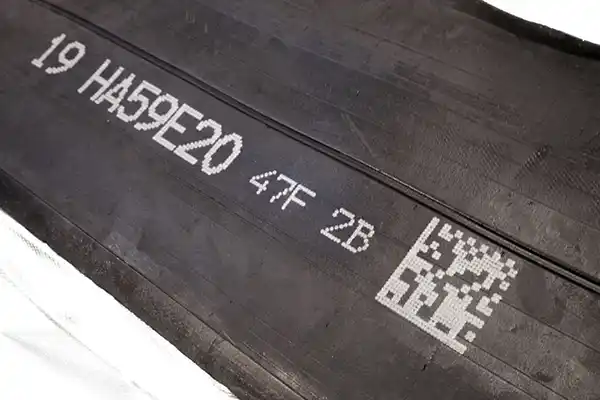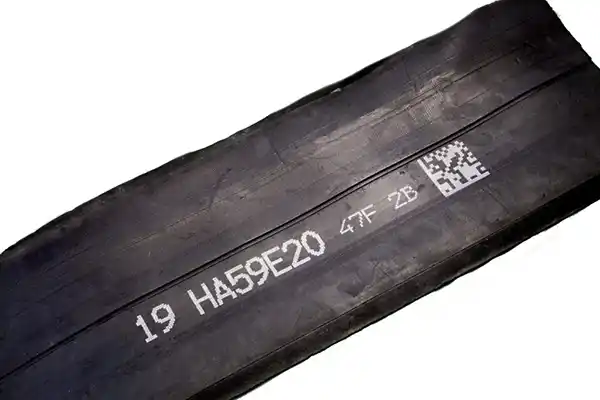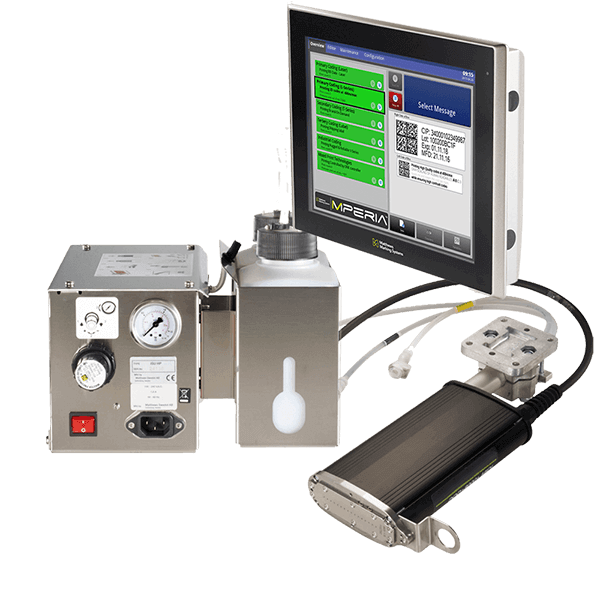Is it time to retire your old, unreliable, poorly integrated, legacy rubber and tire marking systems?
By Kevin Havre
Marking, coding, and labeling have been a vital part of tire manufacturing since John Dunlop and Charles Goodyear discovered vulcanization and applied it to automotive tires in the late 1880s.
Beginning in the 1980s and 1990s the industry has largely transitioned away from early contact-based marking methods to more modern and versatile contactless inkjet printers as well as laser engraving and automated print and apply labeling.
Now, as we start 2024, it may be time to evaluate if some of the first generation and legacy equipment – including contact print methods that persist – need to be upgraded. Even though the older equipment may be functional, it’s well worth the effort involved with determining if there’s more advanced equipment that could improve reliability and efficiency, lower total cost of ownership and reduce environmental impact.
Tire manufacturing places unique demand on marking and coding machinery and inks. For example, only the tire and rubber industry requires curable inks that can withstand the curing process. And, track-and-trace marking on green rubber that must be removed after (or during) vulcanization, then marked on the final product. An off-the-shelf CIJ printer intended for marking bottles simply won’t work.
So, what is the best combination of rubber print technology and inks to deliver the traceability standards that the tire industry demands? Let’s take a look.
Top factors to consider for rubber marking
1. Must withstand dust and debris
The biggest enemy of a printer is dust and debris. A global tire producer was experiencing inconsistencies in equipment performance and traceability on its tread line thanks to an outdated contact printer and inkjet system. In particular, clogged printheads were driving up maintenance costs.
One way to avoid such problems is through the use of valvejet drop-on-demand (DOD) print technology designed specifically to perform in harsh industrial conditions. It works by propelling pressurized ink toward the rubber through precisely machined nozzles. This action means there’s no chance of dust or particles entering internal components.
2. Must be able to stand the heat
Many print technologies struggle with significant changes in temperature and humidity resulting in low-quality marks and poor outcomes. High levels of humidity can cause ink to streak or smudge during printing. In very dry environments, ink has the opposite problem and can be too faint, light, or appear faded. Both of these factors can lead to codes becoming illegible, or in the case of barcodes or data matrix 2D codes, unscannable.
To avoid such problems, you’ll want to look for efficient ink delivery solutions that supports both pigmented and dye-based inks. In addition, you’ll want to ensure that you are using high-quality inks engineered for your environment. High quality inks ensure not only exceptional print quality but also safeguard the longevity of your equipment and enhance overall productivity.

3. Availability of low VOC inks
The choice of ink is especially crucial for efficient tire and rubber marking. The inks must adhere to rubber surfaces effectively, withstand harsh manufacturing processes, and remain durable under challenging conditions. But it’s not enough to tick these boxes – tire manufacturers also need VOC-free inks to help meet ever more stringent emissions regulations.
Up until the digital era, the primary means of producing tire marks was with roll coders and offset printers that required the use of caustic and dangerous VOC inks to feed messy mechanical printers and coders.
The shift to more efficient inkjet printing technology alone significantly reduced ink consumption and the associated environmental impact. More recently, that environmental impact has been reduced even further with the advent of curable, true zero VOC- and HAPS-free inks.
Here at Matthews, we introduced an advanced true-zero VOC ink at ITEC 2022 that matches the performance of VOC-based inks. Our white VOC-free inks are now in use at dozens of tire manufacturing plants around the world.
4. Need for custom mounts and brackets
In tire and rubber manufacturing, generic mounting stands and brackets rarely fit every application. If such challenges exist in your environment, a custom solution could be the best option.
For example, V-Series drop-on-demand printheads can be mounted over, under, and beside lines or on traversing systems that move printheads around oddly shaped surfaces. Other possibilities are custom kick brackets that can snap out of the way to protect the printhead from damage due to repeated hits, rotating printheads, and flexible print mounts that can raise and lower print heads to suit varying thicknesses.
5. Keep the pace
High-speed production is another challenge for tire traceability. The fast-paced nature of high volume tire manufacturing requires a marking solution that can keep up with production speeds while ensuring precise and consistent marks on rubber slabs and tires.
This is where valvejet drop-on-demand printers stand out. Because valvejet printheads never contact the rubber surface, they create clear, crisp alphanumeric and lot codes marks with high print quality – even at high speeds and without damaging the rubber. For example, our V-Series valvejet DOD printer can deliver speeds up to 780 ft/min (240 m/min).
6. Maintain high print quality on uneven surfaces.
Uneven and oddly shaped surfaces are another factors that can impact print quality. To minimize such problems, look for printheads such as our V-Series that can be placed further away from the substrate without significantly impacting mark quality. This typically eliminates some inkjet technologies such as thermal inkjet (TIJ) that have comparatively small throw distance specifications.

Does the perfect rubber marking solution exist?
To withstand the harsh, fast-paced conditions typically found in rubber and tire plants, you need rugged printers and specialized inks that are up to the task – and they do exist! The best option is to work with an experience provider to custom engineer a solution for your unique requirements.
For over 60 years, Matthews Marking Systems has partnered with the tire and rubber industry, supplying many of the world’s leading tire manufacturers with systems and inks that make reliable, durable marks possible.
Our V-Series is used at major tire factories worldwide and has proven reliability for large character marking on rubber and tires. The V-Series printheads are capable of more than 9 billion firings before tuning is required and use recirculating bulk ink supply systems, reducing the need for staff to monitor and replenish ink during operation.
V-Series printheads use a range of inks, including:
- Low-VOC and HAPS-free pigmented inks
- Disappearing ink, for marking green rubber
- A large variety of UV inks
- Curable inks that withstand the curing process
- Specialized custom-designed inks
For one global tire manufacturer, the V-Series with a bulk ink delivery system put an end to persistent maintenance and mark quality problems. The company’s existing marking system included an outdated contact printer and a competitor’s inkjet system, which had become unreliable due to clogging jets.

The final component for this firm was the MPERIA universal print controller, which accesses the plant’s ERP system and sends recipe data directly to the printer’s controller. An integrated scale measures the weight of the tread, with the message changing to “XXXX” if the tread stock goes over or under required weight limits.
Following an initial evaluation at a single plant, this manufacturer has since rolled out the Matthews solution to four additional plants.
Book your free demo.
If you’re coping with old or unreliable marking equipment, an upgrade can make a world of difference. The first step to better solution is contact us for a free on-site demo by filling out the quick contact form below.
